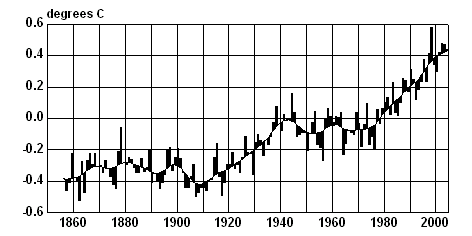Tiempo Climate Cyberlibrary
Global Climate 2004
- Tiempo archive
- Complete issues
- Selected articles
- Cartoons
- Climate treaty
- Latest news
- Secretariat
- National reports
- IPCC
About the Cyberlibrary
The Tiempo Climate Cyberlibrary was developed by Mick Kelly and Sarah Granich on behalf of the Stockholm Environment Institute and the International Institute for Environment and Development, with sponsorship from the Swedish International Development Cooperation Agency.
While every effort is made to ensure that information on this site, and on other sites that are referenced here, is accurate, no liability for loss or damage resulting from use of this information can be accepted.
|
According to the World Meteorological Organization, the provisional annual value places 2004 as the fourth warmest year in the global surface air temperature record, which extends back to 1856. The year was also notable for tropical storm activity in the Atlantic and Pacific. Newswatch editor Mick Kelly reports. |
|
|
© Tiempo |
|
Global surface air temperature: annual values as departures from the 1961-90 mean and smoothed curve |
|
The global surface temperature average for the period 2000-04 was 0.20 degrees Celsius higher than the average for the 1990s. The rate of change since the mid 1970s, when the latest warming phase began, has been three times that over the past 100 years. The ten warmest years world-wide have occurred since 1990.
During 2004, the warmth was particularly marked over central Asia, China, Alaska, parts of the western United States and the North Atlantic Ocean. The year saw the warmest October on record over the world's landmasses.
2004 was also notable for hurricanes and typhoons. The first recorded hurricane in the South Atlantic Ocean occurred in March 2004. A record number of eight storms formed in the North Atlantic during August 2004 and the seasonal total for the region was 15 - the long-term average is ten. Tropical Storm Jeanne killed over 2,000 people in Haiti. Nine major storms struck the United States, resulting in damage estimated at over US$43 billion. Japan experienced a record number of ten tropical storm strikes, resulting in 209 fatalities. Towards the end of the year, a series of storms in close succession devastated parts of the Philippines leaving over 1,600 people dead or missing. Over the eastern Pacific as a whole, storm activity was below normal.
The United States experienced a record number of tornadoes in 2004. "The number of tornadoes associated with tropical storms and hurricanes was extraordinary and can be partially blamed for the high number of overall tornado reports," according to Dan McCarthy of the NOAA Storm Prediction Center.
Much of Africa was affected by below-normal rainfall amounts during 2004, with parts of southern Africa experiencing dry conditions early in the year. Multi-season drought continued across parts of the Greater Horn of Africa. Kenya experienced an early end to the long rains. Food security was threatened by drought in Somalia and drinking-water shortages were made worse by poor rains in Eritrea.
Parts of India experienced moderate drought conditions with the summer monsoon rains 13 per cent below normal. Drought also affected Pakistan, Afghanistan and southern China. Southern and eastern Australia has been affected by hydrological drought since the major drought of 2002/2003 and drought continued to affect parts of the western United States. Heat and dry conditions resulted in a record area being burnt by wildfires in Alaska.
Weak El Niño conditions developed during the year, as anomalous warmth in the central and east-central equatorial Pacific increased and expanded eastwards. Atmospheric conditions are also showing only weak El Niño characteristics. The Southern Oscillation Index has been negative since June 2003, but has fluctuated considerably.
Further information
The global surface air temperature record is available for
download.
Links to current climate monitoring information can be
found in
Tiempo Climate Newswatch.
On the Web
The World Meteorological Organization press
release on the climate of 2004 is available
on-line.
Bright Ideas

General Electric plans to cut solar installation costs by half

Project 90 by 2030 supports South African school children and managers reduce their carbon footprint through its Club programme

Bath & North East Somerset Council in the United Kingdom has installed smart LED carriageway lighting that automatically adjusts to light and traffic levels

The United States National Oceanic and Atmospheric Administration and the American Public Gardens Association are mounting an educational exhibit at Longwood Gardens showing the link between temperature and planting zones

The energy-efficient Crowne Plaza Copenhagen Towers hotel is powered by renewable and sustainable sources, including integrated solar photovoltaics and guest-powered bicycles
El Hierro, one of the Canary Islands, plans to generate 80 per cent of its energy from renewable sources

The green roof on the Remarkables Primary School in New Zealand reduces stormwater runoff, provides insulation and doubles as an outdoor classroom

The Weather Info for All project aims to roll out up to five thousand automatic weather observation stations throughout Africa

SolSource turns its own waste heat into electricity or stores it in thermal fabrics, harnessing the sun's energy for cooking and electricity for low-income families

The Wave House uses vegetation for its architectural and environmental qualities, and especially in terms of thermal insulation

The Mbale compost-processing plant in Uganda produces cheaper fertilizer and reduces greenhouse gas emissions

At Casa Grande, Frito-Lay has reduced energy consumption by nearly a fifth since 2006 by, amongst other things, installing a heat recovery system to preheat cooking oil
Updated: May 15th 2015
